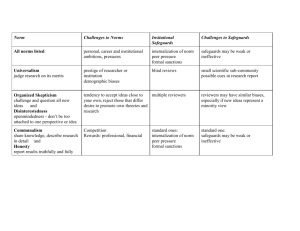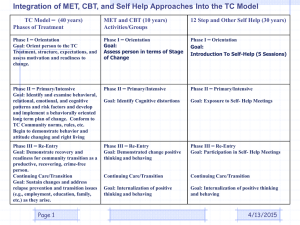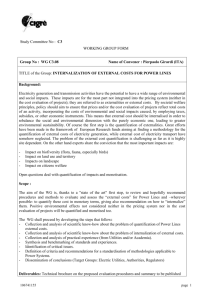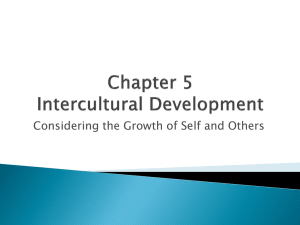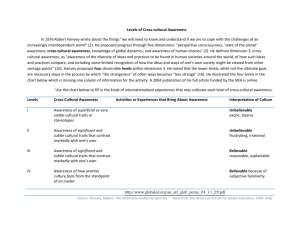cross-cultural generalizabnility of organizational commitment and its
advertisement
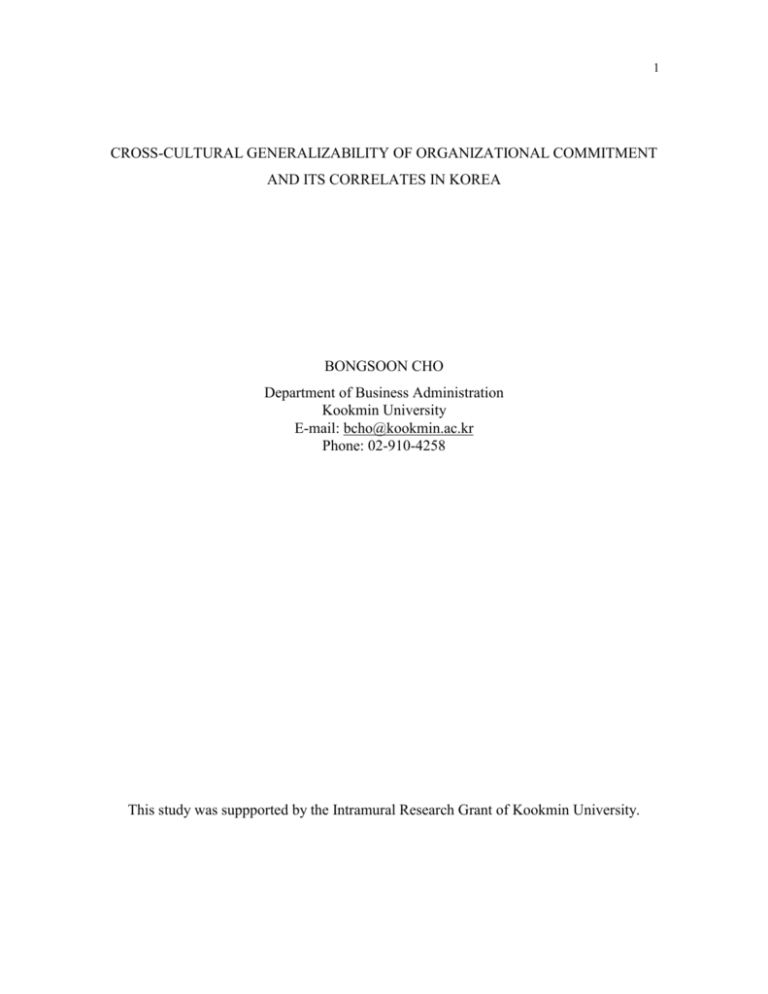
1 CROSS-CULTURAL GENERALIZABILITY OF ORGANIZATIONAL COMMITMENT AND ITS CORRELATES IN KOREA BONGSOON CHO Department of Business Administration Kookmin University E-mail: bcho@kookmin.ac.kr Phone: 02-910-4258 This study was suppported by the Intramural Research Grant of Kookmin University. 2 CROSS-CULTURAL GENERALIZABILITY OF ORGANIZATIONAL COMMITMENT AND ITS CORRELATES IN KOREA ABSTRACT This study examines the cross-cultural transferability of organizational commitment as a construct in relation to Korean employees. O’Reilly and Chatman’s organizational commitment scale was used to test whether organizational commitment has the same construct validity and criterion-related validity in a Korean context. This study also compares the concept of organizational commitment in relation to both professional and non-professional employees. The relationships typically found in the United States between organizational commitment measures and other theoretically related variables were also [delete also] found in the investigation of a Korean sample group [delete group]. In addition, differing magnitudes of work-related commitments, i.e., organizational commitment and career commitment were found between professional employees and non-professional employees in this sample. The concept of the transferability of organizational theories and measures across cultures was generally supported. Key Words: organizational commitment, cross-cultural transferability, professional and non-professional employees 3 I. Introduction Sekaran (1981) has noted that "A major concern in cross-cultural studies is that concepts and measures developed for organizational research in the United States may be culture bound" (p. 409). Comparative management has been a scholarly battlefield regarding this issue. For example, Farmer and his colleagues (Farmer & Richman, 1964; Farmer, 1973) argue for the significance of cultural constraints on managerial behavior while Negandhi and his colleagues (Negandhi & Estafen, 1965; Negandhi & Prasad, 1971) argue that uniculturally-developed theories can be applied to other cultures. However, the issue seems to have spawned more argument based on opinion than on empirical investigations. This is largely due to the methodological complexities and difficulties inherent in empirical cross-cultural research (Ronen, 1986), as they create a prevailing sense of pessimism with regard to arriving at conclusive outcomes. A major problem in cross-cultural research has been the question of how best to conceptualize cultural effects. Differences among measured variables and their relationships to each other have often been attributed to culture (cf. Whitely & England, 1977; England & Negandhi, 1979). Dossett and Lee (1988) have argued that measurement residuals may be indicators of cultural response bias and that such residuals can be quantified and/or controlled. Culture effects and cultural response bias are two different things; culture effects are reflected in the "true score" component of measured variables while cultural response bias is the source of a non-random measurement error. The notion of the cross-cultural transferability of organizational constructs and theories assumes that cultural response bias has been controlled. Otherwise, empirical relationships of theoretical interest found in one culture may not be statistically significant when applied to another culture, even when similar empirical relationships in that other culture are, in fact, substantial The present investigation provides additional evidence regarding the cultural transferability of O'Reilly and Chatman's (1986) organizational commitment measures vis-a-vis a replication study conducted in Korea. I hypothosized that the constructs of internalization, identification, and compliance in organizational commitment are evident, as are the relationships with other theoretically relevant variables that O'Reilly and Chatman have identified. 4 II. Organizational Commitment Although a great deal of research has been conducted into organizational commitment, resultant concepts are often criticized for their poor definitions or measures (Swailes, 2002). Staw (1977) commented that the value of commitment as a separate construct distinct from other psychological concepts (e.g., motivation, involvement, behavioral intention) remains to be demonstrated. Other researchers (e.g., Kanungo, 1979; Scholl, 1981; Wiener, 1982; O'Reilly & Chatman, 1986) believe that theoretical and operational definitions should clearly differentiate commitment and its components from other related constructs. In this regard, OCQ (Organizational Commitment Questionnaire), one of the most widely used measures of organizational commitment (Mowday et al., 1992), has been harshly citicized for not carefully separating its consequences, i.e., turnover intention (e.g., Reichers, 1985). A few efforts have been made to overcome problems with existing constructs. For example, Meyer and Allen (1991) proposed a three-component model of organizational commitment that is composed of continuous, affective, and normative dimensions. This measure has been supported through testing construct validity (Meyer et al., 1993) and meta-analysis (Meyer et al., 2002). Its applicability outside North America countries such as China (Cheng and Stockdale, 2003) and Korea (Ko et al., 1997) has also been strongly supported. O’Reilly and Chatman’s attempt to conceptualize organizational commitment is also noteworthy, although less highlighted. Based on the Kelman’s notion of how individuals accept influence (Kelman, 1958), O’Reilly and Chatman (1986) defined organizational commitment as a multi-dimensional construct composed of three aspects: (a) compliance, or instrumental attachment due to specific, extrinsic rewards; (b) identification, or attachment based upon a desire for affiliation; and, (c) internalization, or attachment predicated on a congruence between individual and organizational values. Despite its theoretical soundness, relatively little research has been conducted to verify the validity of these three commitment facets (Vandenberg et al., 1994). Some empirical studies using these measures have explored the relationships between these facets and resultant variables such as turnover intention and pro-social behavior (O'Reilly & Chatman, 1986; Vandenberg & McCullin, 1989; Vandenberg et al., 1994). However, such 5 relationships need to be examined further to provide more complete evidence for the construct validity of these measures. Of theoretical interest, too, are the differences among relationships between professional and non-professional employees. Professionals – “cosmopolitans" as Gouldner (1957) calls them - have been considered a distinctive group whose work attitudes and behaviors are quite different from those of other employees. For example, as Gouldner proposed, experts (or professionals) are less likely to become "locals" (those high on loyalty to the employing organization, low on commitment to specialized role skills, and likely to use an internal reference group) because of the skills they possess, which have been acquired through extensive training. It has been posited that professionals are primarily committed to their occupation rather than to their employing organization (Blau & Scott, 1962; Shore and Martin, 1989). To examine such matters further, the differences in work attitudes and behaviors between professionals and non-professionals were investigated using O'Reilly and Chatman's three-facet measure of organizational commitment. In summary, this study examines: (a) the applicability of organizational commitment facet measures developed in the United States to Korean culture; (b) the antecedents and consequences of internalization, identification, and compliance; and, (c) the differences between professional and non-professional employee groups. Its specific hypotheses are as follows: Hl: Internalization, identification, and compliance are three distinctve dimensions of organizational commitment. H2: Internalization is more influenced by cognitive antecedent variables among nonprofessional than among professional employees. H3: Extrarole behavior is related to a commitment that is rooted in identification and internalization but not in compliance-based commitment (O'Reilly and Chatman, 1986, p. 493). H4: Intention to turnover is positively related to compliance (Vandenberg and McCullin, 1989, p. 234), and negatively correlated with identification and internalization (O'Reilly and Chatman, 1986, p. 493). 6 H5: Organizational commitment attitudes of professionals are less predictive of intentions to remain in an organization than those of non-professionals (Shore & Martin, 1989, p. 635). H6: Professional employees are less committed to their organizations than non-professional employees (Wallace, 1993). Specifically, internalization and identification are stronger among non-professionals but compliance commitment does not differ between the two groups. H7: Professionals demonstrate higher levels of career commitment than non-professionals. III. Method 1. Subjects and Procedure The sample consisted of 274 Korean employees from 14 different organizations located in Korea. Approximately 25% of the group were employed in the chemical and electronics industries, 16% in research institutes, 13% in communications, and the remainder in airline, retailing, and CPA companies. The sample consisted of 169 non-professionals (either managerial or clerical) and 105 researchers who had received at least two years of professional training (i.e., master’s or Ph.D. degree). Less than 5% of the professionals had received training at universities outside of Korea. Questionnaires were administered on company time resulting in a response rate of approximately 82%. The mean age of respondents was 28.0 years (s.d. = 4.4) and their mean tenure at their respective organizations was 3.3 years (s.d. = 2.0). About one fifth (19.3%) of the sample was female. 2. Measures O'Reilly and Chatman's 12-item scale for measuring facets of organizational commitment (i.e., internalization, identification, compliance) was used. A career commitment scale (seven items) was also developed (coefficient α = .82). Cognitive variables theoretically antecedent to commitment included work-group cohesiveness (adapted from Price & Mueller, 1986), pay satisfaction and job equity cognitions (Scholl, Cooper, & McKenna, 1987), promotional opportunities (three items adapted from Curry, Wakefield, Price, & Mueller. 1986), and employment opportunities (Curry et al., 1986). The relability coefficients for these scales were 7 .70, .91, .88, and .80, respectively. Perceived alternative employment opportunity was measured with a single item (Curry, et al., 1986). In addition, a three-item organizational prestige scale was developed specifically for this study (α = .76). The items were: "My organization has a good reputation externally"; "When I tell other people that I work for this organization, they tend to trust me"; and, "My friends are envious of the fact that I work for this organization". To assess job related behavior and behavioral intention as consequences of organizational commitment facets, the 16-item measure of organizational citizenship behavior (Smith, Organ, & Near, 1983) and three-item measure of intention to turnover (Michaels & Spector, 1982) were included. Reliability coefficients were .80 and .82, respectively. All items in the survey were anchored by 7-point ‘Strongly Disagree’ to ‘Strongly Agree’ response scales. Demographic variablesincluded level of education, organizational tenure, actual salary, and the number of dependents supported by the employee. 3. Translation Procedure All scales (except organizational prestige) were developed in the United States. To reduce possible cultural response bias (Malpass, 1977), considerable effort was expended on item translation. Translation, in particular, has been identified in the past as a critical problematic. Brislin (1970) has enumerated the problems of simple back-translation; Hulin (1987) has noted that high-quality back-translations do not ensure that scores based on two different language versions are psychometrically equivalent. Consequently, for this study, two Korean bilinguals translated the questionnaire items which were then reviewed by another Korean. The translated items were then distributed to several employees who were asked to identify any strange or nonsensical expressions they found while responding to each item. Identified items were modified in consultation with the respondents and the modified version was given to a different group of employees. This iterative process was terminated after the third round when no additional problems were identified. A total of 20 individuals were involved in pilot testing the items. Thus, it is believed that the problems of simple translation and back-translation identified by Hulin and Mayer (1986) were minimized. 8 IV. Results Since the objective of this research was to assess the cross-cultural variability of constructs/measures developed in the United States, data analysis was conducted with a confirmatory as opposed to an exploratory approach. Thus, the 12 items of O'Reilly & Chatman's (1986) organizational commitment scales were subjected to confirmatory factor analysis via the AMOS computer program. Except one item on, all observed variables showed significant structural coefficients, or loading scores withintheir intended scale. The low-loaded compliance item (“my private views about the organization differ from those I express publicly”) was dropped for further analysis. The resulting 11-item solution produced a χ241 = 90.913 and showed fit indices within the acceptable ranges (Hu & Bentler, 1999) such as NFI = .987 and RMSEA = .067. I compared this three-factor model with a two-factor model (combining internalization and identification items in one factor and compliance in the other) and a one-factor model (combining all items into a single factor). The results showed that the three-factor solution was better than the one- or two-factor solution, supporting the adequacy of the three-factor solution for the Korean sample (See Table 1). Compared to the two- or one-factor model, the three-factor model showed a significant drop in χ2 statistics, which suggests that it better explains data results. Table 2 presents the final commitment facet correlations and coefficient α reliability estimates. In this study, the reliability of the compliance facet was unacceptably low (α = .47). A similar poor reliability of the compliance facet has been reported in a previous study (Vandenberg et al., 1994) where coefficient α was only .29. Although the correlation between the internalization and identification facet was high (r =.54), the two-factor solution did not improve on the the threefactor solution as a suitable model. Thus, the hypothesized factor structure of internalization, identification, and compliance commitment was judged as generally transferable from American to Korean culture. Insert Table 1 and 2 about here The sixteen Organizational Citizenship Behavior items (Smith, Organ, & Near, 1983) were also subjected to confirmatory factor analysis for in-role and extra-role behaviors. Since the 9 results indicated the possibility of a factorially more complex solution (adjusted goodness-of-fit only .86), five items were deleted to simplify the factor structure and better represent the two hypothesized factors. The resulting 11-item confirmatory solution resulted in an adjusted goodness of fit index of .91, the lack of model fit being due to several large item cross-loadings on the two factors. However, these items appeared to define the in-role (six items, = .77) distinctly enough from the extra-role (five items, = .71) constructs, as intended, and support the cross-cultural generality of constructs and measures development in U.S. samples when applied to Korean nationals. Table 3 presents regression analyses for the antecedents of organizational commitment. The six cognitive variables (organizational prestige, perceived work group cohesiveness, pay and job cognitions, perceived promotional opportunity, and perceived employment opportunity) were entered into the equations as a group as were demographic variables. Thus, cognitive variables and demographic variables were tested for any unique contribution they might make to R2 after the other variable group was covaried. It was found that the demographic variables did not add any unique variance over the cognitive variables for any of the three facets among either professional or non-professional employees. This is at variance with the meta-analysis results noted by Meyer et al. (2002), where organizational tenure was significantly related to organizational commitment. Insert Table 3 about here Hypothesis 2 proposed that internalization is influenced more by cognitive variables among non-professional than among professional employees. Internalization in the professional sample was poorly predicted by the independent variables. However, among non-professionals, job equity cognitions and organizational prestige contributed significantly to internalization commitment. Organizational identification based commitment among professionals was significantly influenced by organizational prestige (β = .37) and pay satisfaction (β =.28) while organizational prestige (β = .49) and job equity perceptions (β = .38) had significant beta weights for non- 10 professional employees. Unique cognitive contributions to identification were 36% (p < .001) for professionals and 48% (p < .001) for non-professionals. Interestingly, compliance was negatively influenced by perceptions of job equity for professionals (β = -.24). It appears that perceptions of inequity lead to compliance in this group. I speculate that this might be a temporary condition until alternative employment is available; however, I found no evidence that perceived job opportunity moderated job equity perceptions in either sample. No cognitive variables produced significant beta weights for compliance in the non-professional sample . Table 4 presents correlations between the three commitment facets and self-reported behaviors for professional and non-professional employees. As hypothesized (H3), extra-role behavior was significantly related to commitment that was rooted in internalization and identification. Extra-role behavior was negatively related to compliance-based commitment among non-professionals (r = -.21), whereas it was not affected by compliance-based commitment among professionals. Internalization and identification were negatively correlated with the turnover intention variable in both samples, but compliance was positively correlated with it among non-professionals, supporting Hypothesis 4. These results are also consistent with those of O'Reilly and Chatman (1986) and of Vandenberg and McCullin (1989). Insert Table 4 about here Hypothesis 5 proposed that organizational commitment among professionals would be less predictive of intention to quit than among non-professionals. As shown in Table 4, all three facets of organizational commitment produced smaller correlations among professionals than among non-professionals, although none of the differences were statistically significant. Hypothesis 6 proposed that psychological attachments (internalization and identification) for non-professional employees is stronger than those for professional employees. No significant difference in instrumental commitment or compliance was expected; however, it was expected that highly committed employees will report more job-related effort or behaviors. Thus, organizational citizenship behaviors (both in-role and extra-role) should be stronger among nonprofessional than among professional employees. 11 Table 5 presents t-tests of commitment and citizenship behavior between the two groups. As hypothesized, no significant difference in compliance between professional and nonprofessional employees was found while each of the t-values for perceptions of organizational internalization and identification commitment, as well as both in-role and extra-role behaviors, were significantly higher for non-professionals. However, professionals showed a higher level of career commitment than non-professionals, as hypothesized (H7). Insert Table 5 about here V. Discussion In general, the results of this study support the central research questions addressed. In particular, the hypothesized three-factor structure outlined by O'Reilly and Chatman (1986) reflected the facets of internalization, identification, and compliance commitment. In addition, most of the postulated relationships of commitment with other variables were supported in the results of two Korean samples, paralleling the results of studies conducted in the United States. Consistent with the findings of O'Reilly and Chatman (1986), internalization was positively correlated with extra-role behaviors and negatively related to turnover intention among both professionals and non-professionals. These findings are similar to the results of recent metaanalysis on the Meyer & Allen’s three-component model of commitment (Meyer et al., 2002). Interestingly, both internalization (i.e., value congruence between the person and the organization) and identification (i.e., desire for organizational affiliation) among nonprofessionals were substantially affected by job equity perceptions and by the perceived reputation of the organization. None of the theoretically antecedent cognitive variables was a meaningful contributor to internalization among professional employees. This suggests that organizational value-congruence among Korean non-professionals may be somewhat more malleable in comparison with Korean professionals with a background of extensive training (i.e., master’s or Ph.D.). I suggest that similar research be conducted both in the United States and in other cultures to establish validity for the generalization of these results. 12 Secondly, the results suggest that identification may be a potentially useful index of commitment-related behaviors, as its relationships with both antecedents and outcome variables were generally higher than those of the other two commitment facets. Identification was positively associated with extra-role behavior but negatively related to turnover intention in both employee samples. These results are consistent with those found in the United States (Dukerich, Golden, & Shortell, 2002; O’Reilly & Chatman, 1986) and, thus, support the proposition that commitment concept can be transferred to other cultures. The data also show that one's identification with his or her organization is strongly influenced by the external reputation of the organization. This is consistent with the literature on organizational identification that proposes that the construed external image of an organization influences the strength of organizational identification (Dutton, Dukerich, & Harquail, 1994; Dukerich et al., 2002) Thirdly, compliance (instrumental involvement) was largely unrelated to antecedent job factors; only perceived job equity in pay influenced compliance attitudes, and then only for professional employees. Contrary to common sense, pay satisfaction was not significantly related to compliance among this study’s sample group of Korean employees. This may have occurred because the seniority-based wage system in Korea results in small differences in pay between high and low performers. This may cause a reduced variance in pay cognitions among employees which, in turn, limits the covariation between compliance and pay cognitions. On the other hand, pay equity based on job type is more likely to involve some status differences which may account for the influence of job pay equity on compliance attitudes among professional employees. I suspect that the same relationships would be found in any organization where pay rates are not contingent on performance, regardless of culture. Overall, the same relationships found in the United States with respect to organizational internalization, identification, and compliance commitment were shown to be present in Korea workplaces. The results support the idea that there may be more similarities than differences in attitudes and behaviors of employees in these cultures. At the very least, the results of this study do not support the view of cultural determinism in organizational behavior. While we recognize the importance of cultural differences in organizational behavior, we firmly believe that cultural similarities are a far more predictable and useful basis for building effective communication and 13 management practices within organizations and between cultures. Cross-cultural consistencies are potentially more functional than cultural differences are limiting. 14 References Blau, P.M., & Scott, W.R. 1962. Formal Organizations. San Francisco: Chandler. Brislin, R. W. 1970. Back-translation for cross-cultural research. Journal of Cross-Cultural Psychology, 1: 185-216. Cheng, Y., & Stockdale, M. 2003. The validity of the three-component model of organizational commitment in a Chinese context. Journal of Vocational Behavior, 62:465-489. Curry, J. P., Wakefield, D. S., Price, J. L., & Mueller, C.W. 1986. On the causal ordering of job satisfaction and organizational commitment. Academy of Management Journal, 29: 847-859. Dossett, D. L., & Lee, J. 1988. Examination of cultural response bias. Best Paper Proceedings of the 48th Annual Conference of the Academ of Management, 96-100, Anaheim, CA. Dossett, D. L., & Lee, J. 1989. Cross-cultural validation of work autonomy scales. Paper presented at the meeting of the Society for Industrial and Organizational Psychology, Boston, MA. Dukerich, J., Golden, B., & Shortell, S. 2002. Beauty is in the eye of the beholder: The impact of organizational identification, identity, and image on the cooperative behaviors of physicians. Administrative Science Quarterly, 47: 507-533. Dutton, J., Dukerich, J., & Harquail, C. 1994. Organizational images and member identification. Administrative Science Quarterly, 39: 239-263 England, G. W., & Negandhi, A. R. 1979. National context and technology as a determinant of employees' perceptions. In Organizational Functioning in a Cross-cultural Perspective, G. W. England, A. R. Negandhi, & B. Wilpert (Eds.). Kent, Ohio: Kent State University Press. Farmer, R. N. 1973. Further exploration in comparative management. In Modern Organizational Theory: Contextual, Environmental, and Socio-cultural Variables. Kent, OH: Kent State University Press. Farmer, R. N., & Richman, B. 1964. A model for research in comparative management. California Management Review, Winter: 55-68. Gouldner, A. W. 1957. Cosmopolitans and locals: Toward an analysis of latent social roles. Administrative Science Quarterly, 1: 281-306. Hu, L. & Bentler, P. M. 1999. Cutoff criteria for fit indices in covariance structure analysis: Conventional versus new alternatives. Structural Equation Modeling, 6:1-55. Hulin, C. L. 1987. A psychometric theory of evaluation of item and scale translations. Journal of Cross-Cultural Psychology, 18: 115-142. 15 Hulin, C. L., & Mayer, L. J. 1986. Psychometric equivalence of a translation of the Job Descriptive Index to Hebrew. Journal of Applie Psychology, 71: 83-94. Kanungo, N. 1979. The concept of alienation and involvement revisited. Psychological Bulletin, 86: 119-138. Ko, J., Price, J., & Mueller, C. 1997. Assessment of Meyer and Allen’s three-component model of organizational commitment in South Korea. Journal of Applied Psychology, 82: 961-973. Malpass, R. S. 1977. Theory and method in cross-cultural psychology. American Psychologist, 32: 1069-1079. Meyer, J., & Allen, N. 1991. A three-component conceptualization of organizational commitment. Human Resource Manegement Review, 1: 61-89. Meyer, J., Allen, N., & Smith, C. 1993. Commitment to organizations and occupations: Extension and test of a three-component conceptualization. Journal of Applied Psychology, 78: 538-551. Meyer, J., Stanley, D., Herscovitch, L., & Topolnytsky, L. 2002. Affective, continuous, and normative commitment to the organization: A meta-analysis of antecedents, correlates, and consequences. Journal of Vocational Behavior, 61: 20-52. Michaels, C. E., & Spector, P. B. 1982. Causes of employee turnover: A test of the Mobley, Griffeth, Hand, & Meglino Model. Journal of Applied Psychology, 67: 53-39. Negandhi, A. R., & Estafen, B. D. 1965. A research model to determine the applicability of American management know-how in differing cultures and environments. Academy of Management Journal, 8: 309-318. Negandhi, A. R., & Prasad, S. B. 1971. Comparative Management. New York: Appleton-Century-Crofts. O'Reilly, C., & Chatman, J. 1986. Organizational commitment and psychological attachment: The effects of compliance, identification, and internalization on prosocial behavior. Journal of Applied Psychology, 71: 492-499. Price, J. L., & Mueller, C. W. 1986. Handbook of Organizational Measurement, Pittman Publishing Inc. Ronen, S. 1986. Comparative and Multinational Management. New York: Wiley. Scholl, R. W. 1981. Differentiating organizational commitment from expectancy as a motivating force. Academy of Management Review, 6: 589-599. 16 Scholl, R. W., Cooper, E. A., & McKenna, J. F. 1987. Referent selection in determining equity perceptions: Differential effects on behavioral and attitudinal outcomes. Personnel Psychologv, 40: 113-124. Sekaran, U. 1981. Are U.S. organizational concepts and measures transferable to another culture? An empirical investigation. Academy of Management Journal, 24: 409-417. Smith, C. A., Organ, D. W., & Near, J.P. 1983. Organizational citizenship behavior: Its nature and antecedents. Journal of Applied Psychology, 68: 653-663. Shore, L. M., & Martin, H. J. 1989. Job satisfaction and organizational commitment in relation to work performance and turnover intentions. Human Relations, 42: 625-638. Staw, B. 1977. Two sides of commitment. Paper presented at the annual meeting of the Academy of Management, Orlando, FL. Swailes, S., 2002. Organizational Commitment: A critique of the construct and measures. International Journal of Management Reviews, 4:155-178. Vandenberg, R. J., & McCullin R. S. 1989. Evaluati the lovant implications of compliance and internalization on turnover attitudes and behaviors. Best Paper Proceedings of the 48th Annual Conference of the Academy of Management, 234-238. Vandenberg, R. J., & Self, R. & Seo, J. 1994. A critical examination of the internalization, identification, and compliance commitment measures. Journal of Management, 20: 123-140. Wallace, J. 1993. Professional and organizational commitment: Compatible or incompatible? Journal of Vocational Behavior, 42:465-489. Wiener, Y. 1982. Commitment in organizations: A normative view. Academy of Management Review, 7: 418-428. Whitely, W., & England, G. W. 1977. Managerial values as a reflection of culture and the process of industrialization. Academy of Management Journal, 20: 439-453. 17 Table 1. Model Comparison: Organizational Commitment Changes in χ2 d.f. NFI TLI CFI RMSEA PR AIC χ2 One-factor 244.462 44 .965 .957 .971 .129 .667 310.402 Model Two-factor 201.929 43 42.533** .971 .965 .977 .116 .652 269.929 Model Three-factor 90.913 41 111.016** .987 .988 .993 .067 .621 162.913 Model N = 274, ** p <.01 NFI: Normed Fit Index, TLI:Tucker-Lewis Index, CFI: Comparative Fit Index, RMSEA: Root Mean Square Error of Approximation, PR:Parsimony Ratio, AIC:Akaike Information Criterion Table 2. Correlations among Commitment Facets Internalization Identification Compliance Internalization (.80) Identification .54* (.78) Compliance -.16* -.27** (.47) [Replace the broken pinked table with this new blued table] Internalization Identification Compliance Internalization (.80) 18 Identification .54* (.78) Compliance -.16* -.27** (.47) N = 274. * p <.05, ** p < .01 Coefficient alpha reliability estimates in parentheses. Table 3. Predictors of Organizational Commitment Professionals’ Independent Basis for Commitment Variable INT IDEN COMP Demographic Education .04 -.07 .00 Tenure -.07 .04 -.02 Actual Pay .09 .05 .00 Number of Dependents -.07 .06 -.04 Cognitive Organizational Prestige Work-Group Cohesiveness Pay Satisfaction Job Equity Promotional Opportunity Employment Opportunity .00 .09 .09 .09 .20 -.03 .37** .14 .28** .03 .11 -.11 .18 -.06 -.12 -.24* .10 -.18 Non-professionals' Basis for Commitment INT IDEN COMP -.05 -.09 .13 -.08 -.05 -.04 -.02 .06 .22 .02 -.09 .07 .22* .16 -.01 .23** .02 .08 .49** .05 .04 .38** .02 .08 -.11 -.01 -.02 -.12 -.13 -.15 F 1. 1.17 3. 6.74** 1.30 5. 4.43** 7. 14.99** 9. R2 2. 4. .11 .42 6. .12 8. .23 10. .51 * p < .05. ** P < .01. N = 104 for professional employees and N = 169 for non-professional employees. INT = Internalization, IDEN = Identification, and COMP = Compliance. Entries are standardized regression coefficients. 1.97* .12 19 Table 4. Correlations of Organizational Commitment with Outcome Variables Professionals’ Non-professionals' Self-Reported Behaviors Basis for Commitment Basis for Commitment INT IDEN COMP INT IDEN COMP Extra-role Behaviors In-role Behaviors Turnover Intention .21* .03 -.20* .26** .25 -.45** -.08 -.07 .17 .35** -.06 -.43** .32** .10 -.58** -.21** -.07 .25** * p < .05, ** P < .01 N = 104 for professional employees and N = 169 for nonprofessional employees. INT = Internalization, IDEN = Identification, and COMP = Compliance. Table 5. T-tests on Attitudinal and Behavioral Differences between Professionals and Non-professionals Professional Non-professional Variables Mean S.D. Mean S.D. t d.f. Organizational Commitment: Internalization 3.33 ( .88) 4.07 (1.23) -5.78*** 268a Identification 4.13 (1.15) 4.52 (1.28) -2.58** 273 Compliance 3.86 ( .95) 3.69 (1.19) 1.20 273 a Pro-Social Behavior: In-role 4.61 ( .92) 5.07 ( .94) -3.98*** 272 Extra-role 4.82 (.82) 5.07 ( .79) -2.48** 272 Career Commitment 4.67 (1.09) 4.27 (1.21) 2.79** 273 a. Degrees of freedom based on t-test for heterogeneous variances. ** P < .01, *** P < .001.
